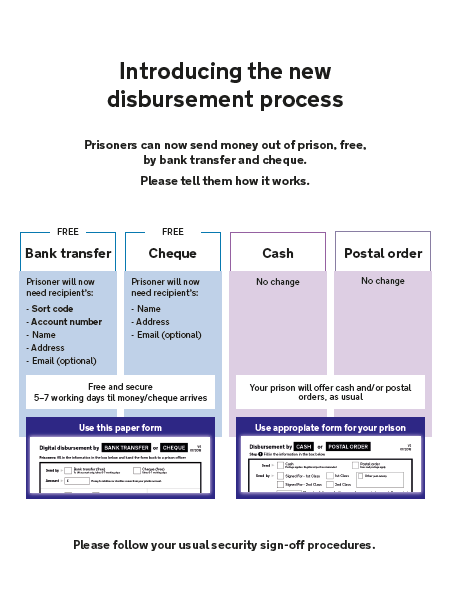In a new prison pilot, the MOJ prisoner money team tests a digital way of sending prisoners’ money out
Why sending money out digitally is such an important service
Many prisoners earn money working in prisons making clothes and furniture or in prison kitchens and laundries. This work is a key part of the rehabilitation process and helps prisoners gain the skills and experience they need to find employment opportunities on release.
Prisoners take pride in sending the money they’ve earned to their children as a birthday gift or to help a struggling spouse to keep outside relationships healthy.
Working, organising money and keeping family contact all play vital roles in rehabilitation.
What did we do?
In our ongoing quest for cashless prisons, the MOJ prisoner money team thought, well, we’ve helped to get money digitally and efficiently INTO prisons so how can we help to get money digitally and efficiently OUT?
So we visited several public prisons throughout the UK to understand how the money that prisoners earn is sent out. Prison staff call this process ‘disbursements’ and we felt sure we could better the process by making it digital.
What was wrong with the old paper process?
Speaking to both prisoners and staff, we saw the process of sending money to friends and family was lengthy, expensive and involved paper-heavy admin which took up valuable prison staff time and effort. We recognised this as an opportunity to simplify and to make the process more secure and economical.
Previously, if a prisoner wanted to send money to a family member for their birthday, they would need to:
- fill out a form
- choose the price of the postage
- state who they were paying and how they wanted to pay (by cash, cheque or postal order)
- have their identity confirmed
- get the form stamped and signed off by a wing officer
Then the staff would need to:
- deliver the form to the business hub
- process it to deduct funds from the prisoner’s account
- if sending out by cheque, write a cheque to be counter-signed by the business hub manager
- if sending out cash, collect cash from the hub cashier
- if sending out by postal order, go to the post office, buy the postal order, post it, then archive the form
The whole process could take anywhere between 10 to 14 days.
So how does the new digital service work?
We came up with a basic idea for an online disbursement (payment) tool that could digitise the second part of the process. We sketched out content and designed a basic prototype which we repeatedly tested, then iterated with prison staff until we were confident it would fulfil as many prisoner and staff needs as possible.
Gradually, we understood the varied complexity of where, how and when prisoners’ money could be sent out. And it WAS varied!
Prisoners still needed to fill in the paper form and have their identity confirmed and signed. But once the form reached the business hub, staff only needed to upload the prisoner details into the new digital tool and click to send the payment request directly to the business support service. The support service then would download and process the request, then send out the money.

The digital pilot
When we were happy with both design and content, we piloted the tool with 8 prisons.
The initial pilot started in January 2018 and was a great success. We had positive and helpful feedback from both prison officers and the prisoners themselves. Processing time was reduced by several days and there were no more postage costs for prisoners.
While the pilot rolled on, we made small, informed improvements to the tool and to the way in which we explained the new process to staff. We worked to reduce the processing time further, aiming for 5-7 days.
This initial success gave us the confidence to expand the pilot to an extra 18 prisons and the feedback and improvements cycle began again.
How sending money out digitally is adding value
To prison staff:
- No more manually copying details from one form to another, meaning fewer mistakes.
- Less paperwork means more time for prison staff to concentrate on other important issues.
- Reducing the need to handle cash or to go out for postal orders, in time hopefully it will disappear altogether
To recipients:
- Simplified process strengthens bonds between recipients and prisoners. This support from people on the outside is crucial when prisoners leave prison.
- Recipients are notified about money arriving so can expect it within 5-7 days.
- Money arrives straight into the recipient’s bank account by bank transfer, so they don’t have to pay a cheque in, then wait for it to clear.
To prisoners:
- Anxiety is reduced because prisoners are told exactly when and how much money has left their account. This is comforting if it’s a birthday gift or payment to a solicitor.
- Creating a simpler process for prisoners to keep in touch with people on the outside is a step towards better, long-term rehabilitation.
- Safer option, especially if they’re used to sending out cash.
- Free. There’s no postage fee.

What’s next?
As we prepare to roll the digital disbursement tool out nationally, we’ll be updating it based on continuing feedback. The new tool sits next to the digital cashbook which is the tool we made for staff to more efficiently process money coming INTO prisons using the ‘Send money to someone in prison’ service.
On top of this work, we’re researching how we can help digitise prisoner ‘discharges’. When a prisoner leaves prison - is ‘discharged’ - the prison needs to give them their money and valuables back in a quick and efficient way.
At present, many prisoners ask for cash when they leave because they know they’ll need money immediately and often don’t have bank accounts. Even when they do have bank accounts, they worry about waiting for the cheque to clear.
Our recent research shows the current process isn’t always the best thing for staff time-wise and for prisoners long-term so we hope this may be another step closer to furthering rehabilitation while also taking cash (and the innumerable problems it causes both staff and prisoners) out of prisons once and for all.

4 comments
Comment by Alan Rider posted on
Great to see this pilot happening. I recall from my previous role in GDS Assisted Digital the user research for the 'Send money to someone in prison' service and I know how much work it takes to get this right.
Well done to the team!
Comment by Jenny Mulholland posted on
Great to be updated on the next success after "sending money to a prisoner" - well done team!
Comment by Jane Stead posted on
Thank you for understanding how much 'nuance' goes into the design and build of these services. We appreciate it!
Comment by Ann posted on
What does it mean to receive one? Is it to be taken to the post office? Or is a cheque to be expected, as that box is ticked?